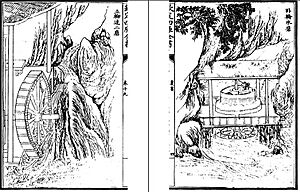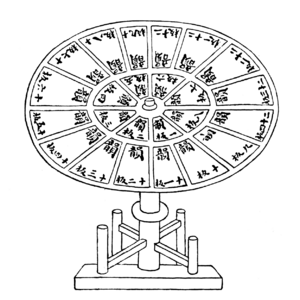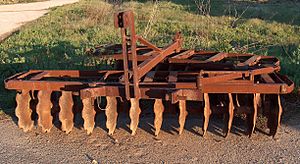Wang Zhen (inventor) facts for kids

Wang Zhen (simplified Chinese: 王祯; traditional Chinese: 王禎; pinyin: Wáng Zhēn; Wade–Giles: Wang Chen, lived around 1290–1333) was a very smart Chinese inventor, engineer, and writer. He lived during the Yuan dynasty (1271–1368). Wang Zhen was one of the first people to create and use wooden movable type for printing. His book about agricultural tools and methods was also very advanced for its time. It showed many different types of equipment and technologies from the late 1200s and early 1300s.
Contents
Wang Zhen: A Brilliant Mind
Wang Zhen was born in Shandong province in China. He worked for many years as a government official in Anhui and Jiangxi provinces. From 1290 to 1301, he was a local leader, called a magistrate, in Jingde, Anhui. Here, he became a pioneer in using wooden movable type for printing.
Wang Zhen wrote about his wooden movable type system in his famous book from 1313. This book was called the Nong Shu (農書), which means Book of Agriculture. Even though the title sounds like it's only about farming, the book actually covered many other topics. It included a lot of information about Chinese science, technology, and farming methods. From machines that used water power to printing with movable type, it was a detailed guide to the technology of medieval China.
Wang wrote the Nong Shu for many practical reasons. He wanted to help farmers in China who were struggling. He hoped his book would show them ways to improve their farms and their lives. The Yuan dynasty had caused problems for farming in China. So, a book like the Nong Shu could help farmers learn how to grow more food and use better tools.
This book was not meant for farmers to read themselves, as most could not read. Instead, it was for local government officials. These officials could then learn the best farming methods and teach them to the people. The Nong Shu was a very long book, with over 110,000 Chinese characters.
Amazing Inventions and Ideas
Wang Zhen was known for several important inventions and improvements.
Water-Powered Bellows
The Chinese were the first to use hydraulic power, like a waterwheel, to work the bellows of a blast furnace. This was for making cast iron. This invention was first recorded in 31 AD by an engineer named Du Shi. After Du Shi, Chinese people continued to use water power for bellows in their furnaces.
Even though Du Shi was the first to use water power for bellows, the first detailed drawing of this machine came from Wang Zhen. His Nong Shu in 1313 showed how it worked. Wang explained how water-powered blast furnaces were used in his time and before.
He wrote that a fast-flowing river could turn a waterwheel. This wheel would then power a system of gears and rods. These parts would push and pull the bellows much faster than people could. This made the process of smelting iron much more efficient. He also described how one main waterwheel could power several bellows at once. This was similar to how water-powered trip-hammers worked.
Wang's Movable Type Printing
Wang Zhen made big improvements to movable type printing. He is most famous for using wooden movable type while he was a magistrate in Anhui province. His main goal was to make printing faster. He did this by creating simple machines and a clever way to organize the wooden types.
Wang explained how to make wooden movable type:
First, a wooden frame is made. Then, bamboo strips are used to mark the lines. A block of wood is carved with characters. This block is then cut into small squares, so each character is a separate piece. These pieces are carefully shaped with a knife to be the same height and size. Then, the types are placed in rows in the frame. Bamboo strips are pressed between them. After all the types are set, wooden plugs fill the empty spaces. This makes sure the types are held firmly and won't move. Once the type is firm, ink is put on, and printing can begin.

Wooden movable type had been tried before by Bi Sheng in the 11th century. But it was not widely used because wood was thought to be too difficult to work with. Wang improved this by adding special ways to cut and finish the type. He also created a special type case and a revolving table. These made the printing process much faster.
In Wang's system, all Chinese characters were organized by their sounds and rhymes. He used a standard book of Chinese rhymes to help with this. He used two revolving tables. One table held the official types from the rhyme book. The other held the most common Chinese characters for quick use. To make it even faster, each character had a number. When a number was called, that character would be picked. If a rare character was needed, wood-cutters would make it right away.
Wang also wrote about how to print new books. He explained that the size of the book needed to be decided first. This would help make the correct size for the wooden blocks used in printing. Ink was put on the type with a brush. Then, the paper was rubbed with a brush from top to bottom to make the print.
Wang also tried printing with tin metal. Tin was easy to melt and cast. But he found that tin type did not hold ink well and made messy prints. So, it was not used for long. Later, in 1490, Hua Sui successfully used bronze metal type in China.
Most of Wang's Nong Shu was printed using woodblock printing. However, his invention of wooden movable type quickly became popular in the Anhui region. Wang's wooden movable type was used to print the local newspaper of Jingde City. This paper used 60,000 characters organized on revolving tables. In 1298, about one hundred copies of this paper were printed in just one month.
Later, in 1322, another official named Ma Chengde used movable type to print important Chinese books. He used 100,000 characters on revolving tables. Metal movable type was also developed in Joseon Korea by the 13th century. But in China, metal movable type was not widely used until the Ming dynasty (1368–1644). Even then, wooden movable type continued to be used until the 1800s. After that, the European printing press invented by Johannes Gutenberg became the main way to print books around the world.
During the Qing dynasty (1644–1911), wooden movable type was used even more widely. The government in Beijing supported it, and private printing companies used it a lot. Making movable type fonts became a good business.
Agriculture and Farming Tools
The main focus of Wang Zhen's Nong Shu was Chinese agriculture. His book listed and described a huge number of farming tools. These included tools used in the past and in his own time. Wang also included many detailed pictures in his book to show each piece of farming equipment.
Wang also created a special farming calendar. It was a circle that showed the seasons, months, and important farming dates. It helped farmers know when to do different tasks, like planting or harvesting.

The Nong Shu talked about many farming practices. These included plowing, planting seeds, and watering crops. It also described how to grow mulberries for silkworms. The book listed many different foods and products from various parts of China.
The book showed not only farming tools but also equipment for processing food. It included irrigation tools, different types of fields, and ways to store grain. It also showed carts, boats, and machines for making textiles (cloth). For example, one drawing showed a huge milling machine powered by oxen. This machine had a large spinning gear that turned eight other mills around it.
Wang also explained the differences between farming technology in Northern China and Southern China. Northern China mainly used dryland farming methods. Southern China used more irrigation because it had more water. Wang used his book to share knowledge. He wanted people in the North to learn about useful tools from the South, and vice versa. For example, the hand-harrow used for weeding in the South was almost unknown in the North.
See also
- History of typography in East Asia
- Woodblock printing
- Hua Sui
- Printing Press
- Johannes Gutenberg
- History of Agriculture
- Agriculture in China
Images for kids








